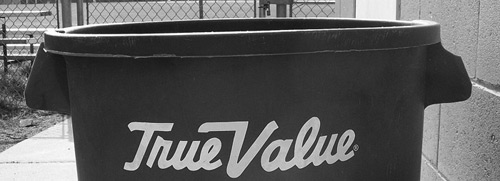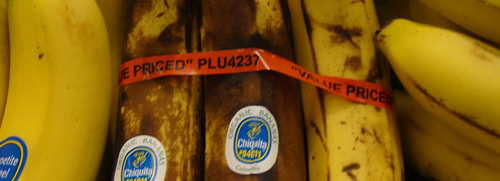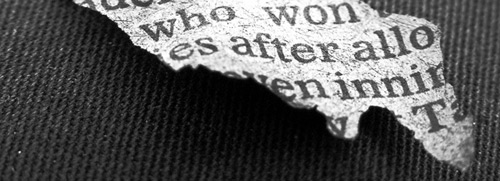I have seen a resurgence in journalists and media folks asking whether news and media should be free or paid. EG: Should the New York Times have a big pay wall in front of it. Traditional media in particular has jumped on this discussion, with the hopes of rebuilding a business model and audience behavior that has eroded or changed dramatically. But I posit:
"Free vs. Paid" is the wrong question.
We should be asking: "Are we serving the most critical needs of our audience?"
Because, in that, business models are made – companies thrive – careers become secure – needs are met – and food is still on the table for all sides of the equation. Unless you are serving a critical need, you are expendable – especially in a recession. Many newspapers are facing this extremely harsh reality, as we are now seeing newspaper closings begin to take shape around the country.
"Audience" does not just mean readers, it means advertisers and business partners as well. For instance, if potential advertisers are reading study after study that people ignore banner ads, then you are obviously not serving their needs if your only offering is banner ads.
First, I want to delve into the debate going on regarding the state of news media, and then dig deeper, exploring the way forward.
I have been reading articles that chastise the newspaper industry for choosing to "give it away." They are referring to decisions made a decade or two ago, when newspapers and magazines either didn’t put up a pay wall for their online content, or took theirs down in order to attract a larger audience.
But in my experience, the news itself was always free – seen for free on the covers of newspapers, through word of mouth, radio, television, and now through various new media and mobile technologies. Newspapers were always incredibly cheap – purchased for less than the price of a cup of coffee, and discarded on train seats and park benches and restaurants for the next person to look through in moments of boredom.
By and large, subscriptions were never very expensive either. For magazines today, many subscription rates are almost non-existent. I pay almost nothing to receive Rolling Stone Magazine, and perhaps $30 or $40 a YEAR to receive the New Yorker every week. I think I was paying $20 a year to receive Newsweek. Is that money funding the massive business structure of that magazine? Doubtful.
How many people spend the $4 or $5 for newsstand copies of these magazines? I have no idea, but I would imagine that the number of people purchasing Rolling Stone magazine has less to do with RS "giving it away" on their website, and more to do with the incredible competition they now face in covering the music industry.
The reality that media companies are facing is that the business model for how they package and sell this news in combination with other services has changed. This change did not occur because some publisher forgot to put up a pay wall. There are bigger things going on here than that. The stature and cultural relevance of newspapers is changing as well. That is the result of competing media channels and the constant inflow of new information and new technology that are open to us all.
The Value Proposition of the Newspaper Has Changed

When people compare the state of the newspaper world of 20+ years ago to today, many tend to focus exclusively on the journalism and news coverage. But newspapers were about so much more than journalism. When I was younger, there were many functions to the newspaper:
- Classifieds: There was no eBay, no Craigslist, no Monster.com, no niche forums, no Zillow.com, no AutoTrader and no web. There was a huge value in picking up the newspaper for the classifieds. Perhaps they are not completely gone, but certainly diminished to a huge degree, and that rate is only increasing.
- Sports Scores & Stats: This is critical information for sports fans. Sure, maybe they watched the game or heard the score before they picked up the paper, but for finding a wide range of scores and deeper stats, this was a critical resource. There is now a huge amount of competition for providing even more stats and articles elsewhere – providing more information in a more flexible way than you can on a printed page. In terms of the web, you have to ask whether a general newspaper can compete with ESPN.com or SI.com in terms of development of new online tools that captures the loyalty of sports fans.
To top it off, people are getting this information up-to-the-minute on mobile devices and becoming part of niche communities for their teams & sports online. The web is filled with thousands of sources for this information, and many ways to interact with it – even creating your own. Again, this hasn’t killed the sports section in the newspaper, but the value is less than it once was.
- Financial Data: I remember my dad staring at page after page of tiny numbers in the newspaper – stock quotes and other data that was mildly scary to me as a child, and only more so now. Again – this information is available much more immediately, comprehensively and flexibly on the web. What’s more, financial service providers now have direct access to people in order to market their data, their reports, etc.
Forums such as FatWallet.com offer something even more compelling – the ability to chat with others about very specific finance topics and share information. There are also a ton of other interesting services that allow people to track their portfolio, debate topics, or compete with others in the financial version of a fantasy league. Interesting stuff that might not be the bread and butter of a broad-based news organization.
You can even argue that the financial crisis we are currently in has not done anything to help the credibility of financial commentary in traditional media. Many have lost money in the market, and perhaps they were following advice they read in the Wall Street Journal or Smart Money magazine or on CNBC. It seems that most are now sitting on the sidelines and will be for years to come. This likely doesn’t do anything to help the situation with journalists & newspapers as the competition continues to encroach online.
- Coupons: Am I wrong in saying this? The Sunday paper comes with this huge stack of coupons and flyers that had a huge place in my household as a kid. That right there, is actual dollar value. People are saving money on food they want, or discovering that Best Buy is having a big sale on an item they want. On the flip side – these companies and advertisers are paying for the direct access to this readership. Newspapers still do this, but I just wanted to point out that this is a value of the newspaper model that gets ignored in arguments about the business model for news.
- Comics: When I was a kid, this was like gold. Or candy. Or gold wrapped in candy. I wonder if the percentage of kids (and adults) who not just read, but truly value newspaper comics has decreased in the past 20 years. There are so many other forms of entertainment that are available with just the click of the mouse, or by pulling out your phone. Waiting on a long line with my iPhone is a very different experience than waiting on a long line without it. Again – just another example that the value of the newspaper was more than just news headlines.
- And the list goes on:
Horoscopes, commentary, lifestyle features, obituaries, local news, restaurant reviews, event calendars, etc. Many of these are now available in compelling forms elsewhere, fragmenting the value of newspapers.Couple all of this with the fact that most people are overwhelmed with news, other information sources, email, full Tivo’s, etc.
"Price is What You Pay, Value is What You Get."

If a business such as a newspaper is finding their business model evaporating, there is a reason. The reason is value. I saw this quote from Warren Buffet recently, and it is relevant here:
"Price is what you pay, value is what you get."
These industries can’t ignore the underlying reasons as to why the behavior of their readers is changing. It is not because they have become spoiled by receiving "free" news for the past decade. It is because our habits as a culture have changed in a dramatic way, and for good reason.
I can easily search classified ads for my entire county or state (for free) via Craiglist. For real estate listings, I can get more information, more immediately. For news, I have access to niche sites, aggregators, blogs, and news sources from around the world. I realize the argument is that if newspapers went away, so would my options for available news sources – but for the most part, I don’t buy it. I think that simply opens up an opportunity for new businesses to grab that attention. One trend I am seeing is that as journalists leave their roles at more established media, the first thing they are doing is starting blogs where they continue to cover their beat. This is all done without a pay wall, as they try to carve out a segment of the market for themselves, and reach the broadest possible audience.
Newspapers and journalists are having to account of the business value of the news on its own – without being packaged with other services like classifieds. As attention becomes more fragmented, I am hearing people say that we should charge for an article on stem cells – put it behind a pay wall or use micropayments to access it. I don’t see how this serves the goals of journalism, and I don’t think it will support a broader business model on the scale that news organizations are accustomed.
There are many other suggestions being floated: a non-profit model of journalism, a Yahoo answers model where people pay to have articles researched and written – and these are nice conversations over a box of caramels, but not likely to save the industry this year.
And let’s face it, charging for general news content during a recession is probably not a great idea. But providing solutions to critical needs – now that’s a horse of a different color…
The Capabilities of Advertisers are Changing
Advertiser needs have not changed, but their ability to fulfill those needs and reach a broader audience in targeted ways – that has changed. One editor at RBI sent me an interesting example of a small company who is creating webcasts to help their potential customers with specific problems. These were high quality productions, and there were a lot of them – something like 10 per month.
This cuts into a traditional B2B media model in a couple of ways at the very least. This same type of advertiser would have once paid a magazine or media brand for:
- Access to the audience (via newsletter lists, a magazine, websites, events, webcasts, etc.)
- Creation of custom products and campaigns (ads, newsletters, webcasts, sponsored webcasts, videos, custom research, events, etc.)
The counter argument to this is that journalists have built trust with the audience over decades, and provide unbiased information. This is true, and this continues to be a core value for B2B media.
But vendors and advertisers who are reaching out directly to their customers are learning very quickly how to do so in authentic ways. Instead of putting their marketing person on a webcast, they are putting an engineer, or lead designer or other employee who is incredibly knowledgeable and passionate about the topic. As these connections are made, new networks are being established – networks outside of traditional media channels.
The Question We Should Be Asking:
How are We Helping People Solve a Critical Need?

This is the question that journalists should be asking themselves. This is the question that publishers should be asking themselves with regards to their advertisers and business partners.
"Critical needs," this can be many things: a problem that is core to their personal, business or family life. Problems that determine whether their career will be secure, their business growing, the needs of their children met, and smaller needs that simply keep people sane. A general rule could be that critical needs are those that keep people up at night.
We have a wide range of tools at our disposal to understand customers better than we ever could have in the past. We can see actual behavior, and can fine tune products with an incredible degree of nuance. But as the recession continues, people’s needs are becoming more dire. Giving them a good nugget of information is nice. Solving a problem that saves their job – that is worth a lot.
The News Should be Free, but Highly Targeted Solutions Should Be Expensive

This is the beauty of B2B media, and why I find it so much more compelling than consumer media. It is about so much more than just attracting an audience. A B2B publisher often serves dozens of small niches – these are communities filled with people who are passionate about a specific topic or industry. I can’t even describe to you how amazing it is to chat with folks around RBI who serve those industries with expertise and enthusiasm.
So here is the goal:
- Identify CRITICAL NEEDS of those in your industry.
- Find immediate and unique ways to serve those needs.
When talking about a paid model, it can work in a number of ways – paid by the consumer or paid by the sponsor. It can include lead generation, webcasts, events (in-person or online), white papers, custom research, supplements, newsletters, blogs, just to name a few. I am not in sales, so there are others much more qualified to discuss the intricacies of these types of offerings.
A new model for journalism and media will not be determined by a group of people in a room deciding how millions of other people should behave. It will happen because you – perhaps by design, luck or shear whim – try out a small experimental idea. If you find even a small degree of success, the next step is to try to replicate this affect. If you can, then you have something. As it grows, as you take small steps in improving the idea, the idea should spread. It should morph, it should be challenged, and it should be experimented with in other industries and other permutations. Only then will it have legs enough to be viable on a broader scale.
The focus on critical needs is the key. We are talking about saving people’s lives – saving their careers, their business and their industry. In doing so, we are saving families from the stress of not having money to provide for themselves, and the stress that stifles decisions that can lead to positive growth.
Otherwise, you may have a "place" in their lives, but not be an essential resource. As the economy continues to disrupt businesses globally, this is a key difference. Many businesses will not survive. Some industries won’t survive. Many careers will see unwelcome changes and transitions. If you become a beacon of light within your niche – if you can prevent some of these things from happening, even in small ways – suddenly, you have incredible power. And yes, this power can have a dollar sign attached to it – PAID, not free. But anything short of solving these problems in targeted and immediate ways is simply less valuable. Differentiating the two is what will set you apart from your competitors.
Content & News is One Part of the Sales Funnel

As media companies experiment with these new ideas, they can’t lump their audience and their products into one stock category. Segmenting their audience will give them a deeper view of who they are serving and how to meet their varying needs.
Paid vs. free belittles the complexity of who they are serving and how they are serving them. Likely, you don’t have one product offering, but dozens of ways that you segment this. From broad based initiatives meant for branding and to capture attention – to very specific products meant for a small but important subgroup of your customer base.
And this is where publishers have to be clever about the mix of traditional and newer opportunities to offer potential advertisers. While display advertising remains core to many campaigns, advertisers often ask for something deeper – something more targeted, something that serves specific needs of theirs. And this is where custom solutions come in – where lead gen and webcasts and events and research and the like become a core part of your offering.
It’s interesting to watch how the music industry is rethinking its sales funnel. The music itself is what appeals to the widest audience – that is the top of the funnel. The industry is beginning to accept that this is the "free" part, that there is more money to be made deeper in the funnel, once you have engaged a broad audience.
Companies like LiveNation understand what George Lucas proved with Star Wars in the 1970’s: merchandising and events are where the real money is. For the music industry it is clothing, ringtones, concerts, access to exclusive events or live chats, etc.
I am a huge fan of newspapers, traditional media, and journalism. As far as I’m concerned, a paper like the New York Times literally creates the news. They do primary research, and uncover stories that no one else would know about. Likewise, because of their authority, if they write about a topic, it often pushes that topic over the "tipping point," making it okay for hundreds of other news sources to begin covering that specific topic as well.
But what I see often is that even though an authority like the NY Times can set the agenda – it is VERY quickly is copied and expanded upon by other traditional and new media sources. What would the world be like without the New York Times? I hope to never find out.
Yes, there is a disruption going on. While empowering new tools and behaviors are being forged in our culture, familiar business models are being shredded. The thing we have to remember is that: we can’t move backwards, only ahead. And we need to do this quickly. Waiting for new standards to emerge before putting a toe in the water will likely mean that you’ve missed the opportunity. Is this unnerving? Is this annoying? Sure. But so were transitional times in history that we read about in awe. We look at those who navigated the changing times nimbly and we admire their confidence and vision. We are in the midst of those times, and you have the power in choosing a new direction.
As all this all relates to B2B media – to serving niche audiences. The question is:
What are we giving readers, advertisers and business partners that is REMARKABLE – that solves critical needs.
Because we live in remarkable times, which will require remarkable things to happen to solve the problems that ail us.




MOBILE ELECTRONIC SOLUTIONS LIMITED is a place to shop for your latest Mobile phones,Laptops, apple ipods and accessories. we provide best quality products for our customers from all over the world with perfect services and We garranty you of a
good and effective service from us.
NOKIA PHONES
**********************************
New Released Nokia X6 32GB (unlocked) Cost $400
New Nokia N97 32GB (unlocked) Cost $400
Nokia N95 8GB $260
Nokia N70.$160
Nokia N71.$150
Nokia E71
Nokia N96 16gb $350
Nokia Aeon $380
Nokia N72.$170
Nokia N73.$180
Nokia N75.$190
Nokia N76.$220
Nokia N82
Nokia E90.$200
APPLE IPHONE
**********************************
Apple iphone 4GB…$200
Apple iphone 8GB…$220
Apple Iphone 16GB..$250
Apple iphone 3G 16GB…$300
Apple iphone 3Gs 16/32GB…$350
APPLE IPOD
**********************************
Apple iPod Classic 160GB =$190usd
Apple iPOD iTouch 8GB = $180usd
Apple itouch 16gb= $204usd
BLACKBERRY PHONE
**********************************
Blackberry.
Brand New Blackberry Javelin 8900 at $310USD
Brand New Blackberry Bold 9000 at $280USD
Brand New Blackberry Curve 8350i at $230USD
Brand New Blackberry Storm 9500 Touch Screen at $300USD
HTC PHONES
**********************************
HTC Touch Cruise=$400usd
HTC P5500 (HTC Nike)= $380usd
HTC P6500 (HTC Sirius) = $340usd
HTC S730 (HTC Wings) = $350usd
HTC X9500 Shift UMPC = $410usd
HTC Touch diamond = $390usd
SAMSUNG PHONES
********************************
Samsung i900 Omnia =$315usd
Samsung i780 = $290usd
Samsung U700 = $220usd
Samsung U600 = $180usd
Samsung U300 = $150usd
Samsung U100 = $120us`
Samsung G800 = $200usd
Samsung G600 = $190usd
Samsung Armani = $240usd
Samsung Serenata = $250usd
SONY ERICSSON PHONES
********************************
Sony Ericsson P1i = $284usd
Sony Ericsson P990i = $270usd
Sony Ericsson K810i = $200usd
Sony Ericsson W810i = $150usd
Sony Ericsson XPERIA X1=$290usd
MOTOROLA PHONES
*********************************
Motorola Razor V3..$140
Motorola Razor V3i.$170
Motorola V500……$130
Dell XPS M1710 cost 500usd
Toshiba Qosmio E10 $650
Toshiba Qosmio F20 $500
Dell XPS m2010 600usd
Dell Inspiron 9300 $530
GAMES
*************************
play station III = $200
Xbox 360 Platinum Bundle Console = $180usd
Nintendo Wii (Nintendo Wii)= $150usd
Sony PSP 4GB Core Bundle = $120usd
CONTACT:Frank Jay
Email :mobilesolutionltd0@yahoo.com
:mobilesolutionltd0@gmail.com
chating mail
msn :mobilesolutionltd@live.co.uk
skyp :mobilesolutionltd
yahoo:mobilesolutionltd0